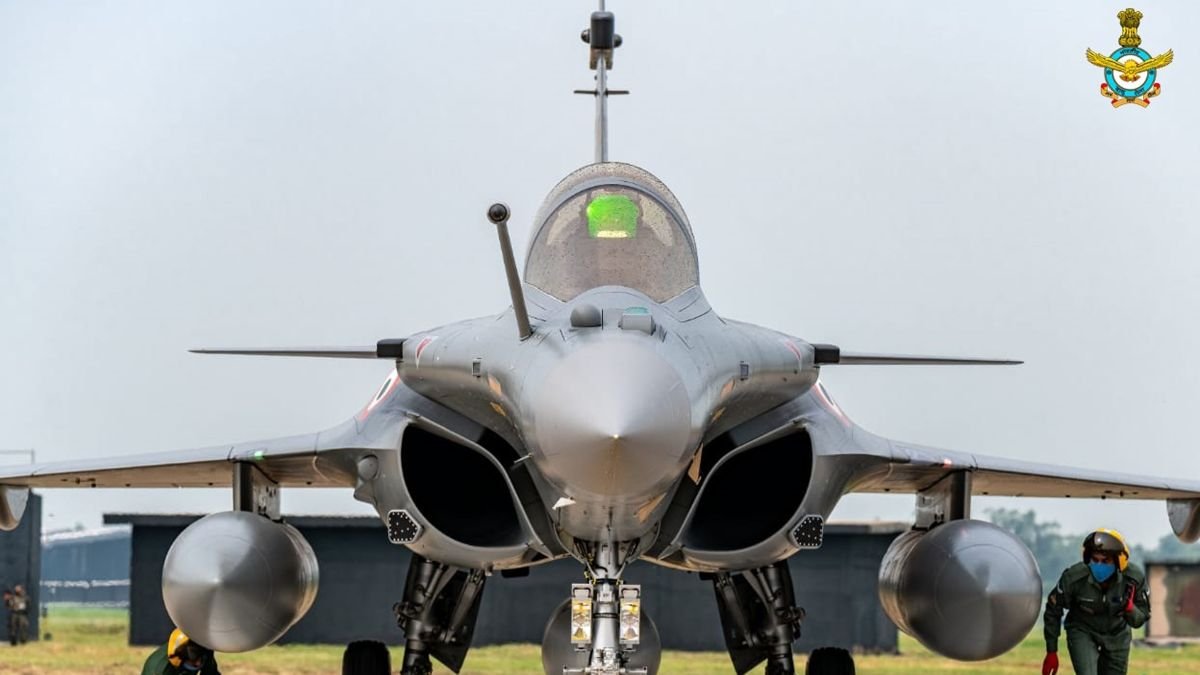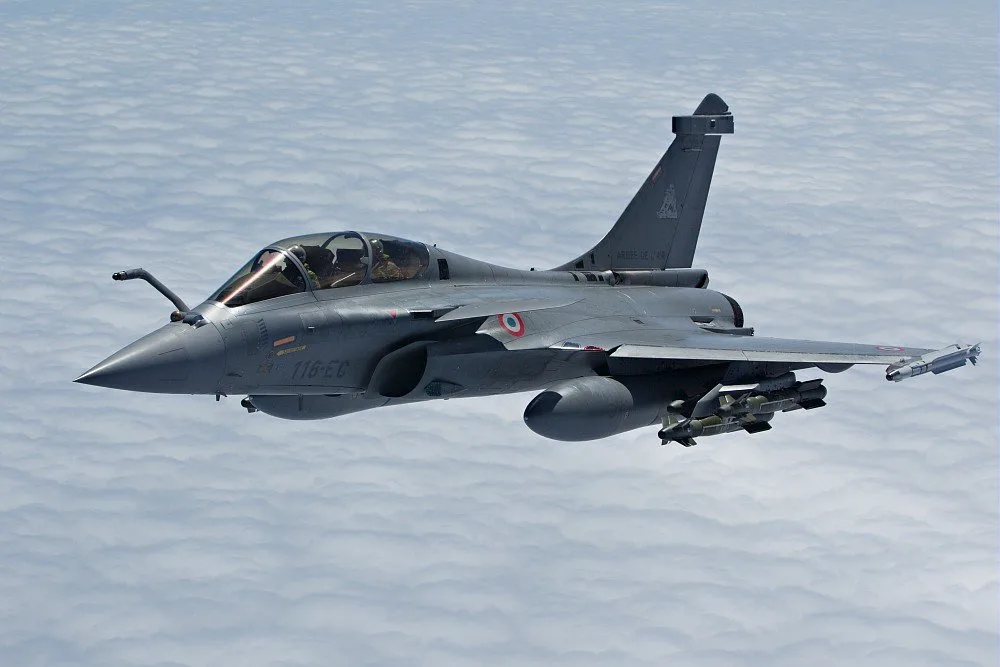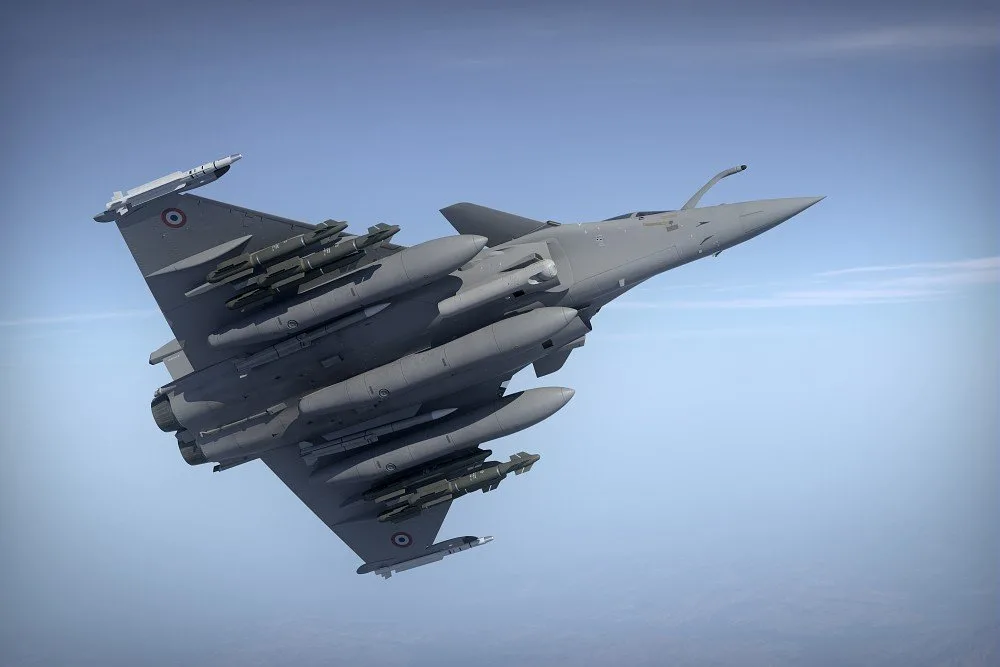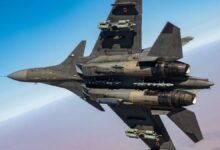Rafale – A Real Game Changer For India ?

The Dassault Rafale is a French multirole fighter aircraft designed and built by Dassault Aviation. It is known for its versatility, advanced technology, and effectiveness in a variety of combat scenarios. The induction of Rafale aircraft into the Indian Air Force (IAF) has significant strategic implications for India’s military balance with Pakistan and China. Here’s a detailed look into the Rafale, including its development, capabilities, and operational history:
Origin:
The Rafale project originated in the 1980s as part of an initiative to develop a new generation of fighter aircraft. Dassault’s goal was to create a versatile aircraft capable of executing air superiority, reconnaissance, ground support, and nuclear deterrence missions. In March 1984, Dassault began developing the “Rafale A” technology demonstrator, which was unveiled on December 14, 1985. This sleek, single-seat, canard delta aircraft was equipped with two General Electric F404-GE-400 engines. The demonstrator’s first flight occurred on July 4, 1986, and it made its public debut in September 1986, with the first production version rolling out in 1988.
Design Features

The Rafale featured a compound-sweep low-mounted main wing and all-moving high-mounted canard foreplane positioned just behind the cockpit. The wing was equipped with full-span elevons and leading-edge slats. Aerodynamically unstable to enhance agility, the Rafale utilized a digital “fly-by-wire (FBW)” system for stability. The aircraft also boasted excellent short-field capabilities, with a brake parachute housed in a fairing below the tailfin.
- Wingspan – 10.90 meters (35 feet 9 inches)
- Wing Area – 46.0 Sq. Meters (495.16 Sq_feet)
- Length – 15.30 meters (50 feet 2 inches)
- Height – 5.34 meters (17 feet 6 inches)
- Empty Weight – 9,060 kilograms (19,975 pounds)
- MTO Weight – 19,500 kilograms (42,990 pounds)
- Max Speed – 2,130 KPH (1,325 MPH / 1,150 KT)
- Combat Radius – 1,095 KM (680 MI / 590 NMI)
Variants:
The production order envisioned three versions of the Rafale:
- Rafale C: The single seat “Rafale C” for the AA, where “C” stood for “Chasseur / Fighter”.
- Rafale B: The two-seat “Rafale B” for the AA, where “B” stood for “Biplace”.
- Rafale M: The single seat “Rafale M” for the Aeronavale, where “M” stood for “Marine”. Although it wasn’t specified at the outset, the Aeronavale also later decided to obtain a two-seat “Rafale BM”.
Rafale C
The Rafale C defined a baseline configuration for the Rafale family. The remarks below apply to the Rafale C, and are followed by descriptions of the other variants and their differences from the Rafale C.
The Rafale C incorporated extensive use of composite materials, reducing both the aircraft’s radar cross-section (RCS) and weight. Despite being relatively small for a twin-engine fighter, it had an empty weight approximately 1,360 kilograms (3,000 pounds) more than a single-engine F-16C, and a maximum take-off weight about 4,535 kilograms (10,000 pounds) greater.
The production Rafale had essentially the same general configuration as the Rafale A but was slightly smaller. It also featured changes to reduce its “radar cross-section (RCS)”, such as improved airframe contours, use of “radar absorbing material (RAM)”, and a gold-plated canopy. In fact, for a time in the early 1990s, Dassault advertised the type as the “Rafale D”, where “D” stood for “Discreet”, to emphasize its semi-stealthy nature.
Additional Characteristics
The Rafale had a fixed, removable in-flight refuelling probe on the upper right side of the nose and tricycle landing gear. The nose gear featured twin wheels, while the main gear had single wheels, all retracting forward. Designed for reliability and ease of maintenance under austere field conditions, the Rafale was built to be a robust and versatile combat aircraft.
Capabilities
Multirole Functionality: The Rafale can perform a wide range of missions, including air-to-air combat, air-to-ground strikes, reconnaissance, and nuclear deterrence.
Avionics and Systems: The Rafale is equipped with advanced avionics, including:
- RBE2 AESA Radar: Provides long-range detection, tracking, and engagement capabilities.
- SPECTRA Electronic Warfare System: Offers comprehensive electronic warfare capabilities, including radar warning, jamming, and decoying.
- OSF (Optronique Secteur Frontal): Infrared search and track system for passive detection and tracking of targets.
Weapons: The RAFALE’s stores management system is Mil-Std-1760 compliant, which provides an easy integration of customer-selected weapons. With its 10-tonne empty weight, the RAFALE is fitted with 14 hard points (13 on the RAFALE M):

- Air-to-Air Missiles: MICA, Meteor, ASRAAM, AMRAAM
- Air-to-Ground Weapons: APACHE, AS30L, ALARM, HARM, Maverick, PGM100 and SCALP EG cruise missiles, AASM precision-guided bombs, Laser Guided bombs, Unguided bombs
- Nuclear Capability: Can deliver the ASMP-A nuclear missile.
- Air-to-Sea: AM39 EXOCET, Penguin 3 and Harpoon anti-ship missile
- The 2500 rds/min NEXTER 30M791 30 mm internal cannon, available on both single and dual seaters.
Performance: The Rafale is known for its agility, speed, and range. It can reach speeds of over Mach 1.8 and has a combat radius of approximately 1,850 km.
Technological Innovations
- Stealth Features: While not a stealth aircraft in the traditional sense, the Rafale incorporates stealth features such as reduced radar cross-section and infrared signature.
- Network-Centric Warfare: The Rafale is designed to operate in network-centric warfare environments, allowing it to share data with other aircraft, ground stations, and naval units in real-time.
- Advanced Cockpit: The Rafale’s cockpit is designed for ease of use and situational awareness, featuring a wide-angle holographic head-up display, touch screens, and a helmet-mounted sight.
For over sixty years, Dassault Aviation, Safran Aircraft Engines, Thales, and their subcontractors have been key players in France’s strategic pursuit of self-reliance in the combat aircraft sector.
The aircraft execute a wide array of missions, including:
- Air-defense/air-superiority
- Reconnaissance
- Close air support
- Air-to-ground precision strike/interdiction
- Anti-ship attacks
- Nuclear strikes
These diverse requirements were integral to the Rafale’s development from the outset, leading engineers to design an aircraft that surpasses the needs of each mission type. The Rafale is versatile and excels across all mission categories, making it a true “Force Multiplier.”
The Rafale has demonstrated exceptional survivability in recent French Air Force and Navy operations, attributed to its optimized airframe and a variety of advanced and discreet sensors. It is expected to remain the primary combat aircraft for the French armed forces until at least 2040.
Key Features of the Rafale:
- Outstanding Stores Carriage Capability: Can carry a wide array of weapons selected by customers.
- Interoperable With All Major Forces: Compatible with various international military forces.
- Affordable Air Power: Cost-effective yet powerful.
- Dogfight Excellence: Superior in aerial combat.
- Combat Proven: Tested and proven in actual combat situations.
- AESA Radar: Represents the future of air defense with advanced capabilities.
- Optronic Systems: Allows passive long-distance identification.
- Data Fusion: Provides a clear tactical situation overview.
- Spectra: Offers comprehensive threat protection.
- Areos Recce Pod: Advanced reconnaissance capabilities.
- Damocles Laser Designator Pod: Precision targeting and strike capabilities.
- State-of-the-Art Man-Machine Interface: Enhances pilot interaction and control.
- Easy Maintenance: Proven support and maintainability.
The Rafale extensively uses composite materials, accounting for 70% of its wetted area, which contributes to a 40% increase in the maximum take-off weight to empty weight ratio compared to traditional aluminium and titanium airframes.
Future Developments
- Upgrades: The Rafale continues to receive upgrades to its avionics, weapons systems, and engines to maintain its competitiveness.
- F4 Standard: The latest upgrade, known as the F4 standard, includes improvements in connectivity, radar, and electronic warfare capabilities. It is expected to be operational by 2025.
Also Read, Su30MKI- The Backbone Of The Indian Air Force
Dassault Aviation & India

The first official win was with India, with the Indian government indicating that the Rafale won a requirement for 126 aircraft. However, weapons deal with India had a reputation for being troublesome, a reputation that was confirmed when the contract was officially cancelled, the stated reason being a failure to come to agreement on local assembly. That ended up being just a stage in the negotiations, with the two parties then coming to an agreement for 36 Rafales, with deliveries in 2020-2022.
In 2016, India signed a deal worth Rs 59,000 crore to acquire 36 Rafale jets from Dassault Aviation, a French aerospace company. This followed a nearly seven-year attempt to procure 126 Medium Multi-Role Combat Aircraft (MMRCA) for the Indian Air Force, which fell through due to disagreements over local production. Compared to the earlier MMRCA deal, the Rafale offers advanced technology, lower life cycle costs, and specifications tailored to India’s warfare needs.
Although the Indo-Pacific has become a region of significant power rivalry, particularly between the US and China, both India and China perceive the Indian Ocean Region (IOR) as a key geopolitical and geoeconomic contest zone. However, they believe this contest is unlikely to escalate into a military conflict in the near future. As a result, airpower has traditionally been of peripheral interest to security planners. This perception began to change with the Galwan Crisis, which highlighted the potential game-changing role of both kinetic and non-kinetic airpower in any future limited conflict along the Line of Actual Control (LAC). The debate within Indian naval and air force circles about the future of maritime air operations and asset ownership in the IOR is timely as India considers military options beyond traditional land-centric strategies against China.
The acceleration of the indigenous Tejas light combat aircraft (LCA) Mk1, the purchase of 36 French Rafale multirole fighters, and an additional 12 Sukhoi Su-30MKI jets from Hindustan Aeronautics indicate a recognition that airpower could play a crucial role in any future India-China conflict. However, delays in the purchase of 22 MiG-29s from Russia and finalizing the 114 multirole fighter aircraft (MRFA) could hinder short- and medium-term capabilities.
The introduction of the PLAAF’s J-20 and nuclear-capable H-6 bombers on the Tibetan Plateau post-Galwan Crisis signals the PLAAF’s growing confidence in matching the IAF in the skies. In April 2014, then-PLAAF Chief Ma Xiaotian emphasized the continuous improvement of the Air Force’s ability to fight and win wars. The PLAAF has 736 advanced fourth-generation platforms, increasing by about 70 aircraft per year with constant technological upgrades. By 2025, the PLAAF’s inventory could include approximately 50 squadrons of fourth-generation fighters and 10 squadrons of fifth-generation J-20s, despite engine design issues. Combined with 5-6 squadrons of H-6 bombers, this poses a significant challenge to the IAF’s current qualitative advantage.
The IAF’s qualitative edge could diminish unless the 114 MRFA aircraft are deployed promptly, alongside advanced electronic warfare systems and stand-off weapons. A mix of Su-30MKIs, upgraded Mirage 2000s, MiG-29s, a limited number of Rafales, and the MRFA could maintain the IAF’s superiority despite numerical disadvantages. The LCA Mk1A, equipped with advanced radars and missiles, will enhance local air defense over Ladakh and support limited battlefield operations along the LAC.
Operational assessments suggest that a limited high-altitude conflict may not extend to the busy shipping lanes of the IOR, given China’s current naval limitations. However, the IAF must be prepared for China’s airpower presence in the IOR, which would significantly alter India’s threat perception. Until then, sea-denial operations are likely to be the primary naval engagements in the IOR. The Indian Navy should develop capabilities for sea-control operations, supported by the IAF’s long-range maritime strike platforms like the Rafale, Su-30MKI, MRFA, AWACS, and aerial refuelers. Recent exercises demonstrate the IAF’s growing extended maritime strike capability, highlighting the importance of additional air bases in Southern India and enhanced infrastructure in the Andaman and Nicobar Islands.
The aerial environment in potential conflicts with China or Pakistan will be fiercely contested. UAV survivability is uncertain, and they should not replace manned offensive platforms. The IAF’s air mobility fleet played a crucial role during the Galwan Crisis, enabling rapid troop and equipment deployment. The IAF’s existing fourth-generation fighters, including Rafales, Su-30MKIs, and upgraded Mirage 2000s and MiG-29s, along with the growing LCA Mk1 fleet, are currently adequate for localized conflicts. However, in a broader conflict, the IAF might struggle to fulfil all its offensive roles, especially if facing a two-front scenario with Pakistan.
OEM/Contractor

Rafale International, a consortium of Dassault Aviation, Thales, and Safran Aircraft Engines, designed the Rafale combat aircraft. By responding to India’s tender to equip the Indian Air Force with state-of-the-art fighters, Rafale International aims to extend its six-decade partnership with the Indian forces, enhance cooperation with Indian industry, and support the “Make in India” initiative.
In alignment with the Indian government’s Skill India initiative, this B2B interface between French and Indian entrepreneurs aims to strengthen existing ties, foster new collaborations, and work towards building a comprehensive defense manufacturing ecosystem in India.
The goal is to develop a complete supply chain to meet the ambitious Rafale offset obligations under the 2016 Rafale contract (50% of the total acquisition contract for 36 Rafales) and to support the success of the Rafale under Prime Minister Narendra Modi’s “Make in India” initiative.
French aerospace giant Dassault Aviation SA is in the process of acquiring land near Jewar International Airport in Noida, Uttar Pradesh, to establish a Maintenance, Repair, and Overhaul (MRO) facility for India’s Mirage 2000 and Rafale fighter jets.
This initiative is a significant step towards the local production of advanced versions of Rafale fighters to address the Indian Air Force’s (IAF) long-term requirement for approximately 100 twin-engine multi-role fighters over the next 20 years.
India and France have agreed on the base price for 26 Rafale M fighters, which will feature several specific enhancements requested by the Indian Navy to enable operations from both indigenous and Russian-origin aircraft carriers. Sources within the defense and security establishment indicated that initial cost negotiations have occurred, with further rounds planned to finalize a contract by the end of this year.
The Rafale Marine (Rafale M) will include several specific upgrades sought by the Indian Navy, such as helmet-mounted displays, low-band frequency jammers, improved radio altimeters, and very high-frequency range decoys, among other enhancements implemented in the IAF’s Rafales. Specific modifications requested by the Navy include software updates for air-to-sea mode, adjustments for electromagnetic interference (EMI) and electromagnetic compatibility (EMC), and software upgrades to enable the aircraft to land on Indian carriers.
The Indian Navy plans to acquire 22 single-seater and 4 twin-seater fighters. The base price of these aircraft, similar to that of the IAF’s Rafales, includes cost escalation considerations. The overall deal is expected to be close to €4 billion (around ₹40,000 crore), covering the basic cost of the aircraft, missiles, and maintenance contracts. Cost negotiations for the Indian side are led by a joint secretary-rank IAS officer and a Commodore-rank officer from the Indian Navy.
A Navy team has already visited the IAF’s Ambala air station to learn from their operations and maintenance of Rafales. The IAF has stationed one squadron of Rafales in Ambala. Both the Navy and Air Force have discussed a common approach to operations and maintenance.
The urgent need for these fighter jets stems from the operational requirements of India’s two aircraft carriers, INS Vikramaditya and INS Vikrant, currently in service. The existing fleet of MiG-29K fighters has underperformed due to maintenance issues. Following trials of both the Rafale M and the F/A-18 Super Hornet from Boeing, the Navy opted for the French aircraft, leading to detailed techno-commercial negotiations earlier this year.
The Rafale M jets will be customized to meet Indian requirements and integrated into the Russian-origin Aviation Facility Complex (AFC) on the aircraft carriers, posing technical challenges. These jets will be bought off the shelf, as the numbers do not justify setting up a production line in India. However, France has offered to establish a production line if the order increases to around 100 aircraft, proposing a larger deal for the Rafale fighters.
The Rafale is already operational with the IAF, which ordered 36 jets in 2016 for nearly ₹59,000 crore. The French are strongly advocating for its acquisition in larger numbers. The IAF has a requirement for 114 fighter jets of the same type but is currently pursuing a competitive bidding process for the acquisition. These carrier-borne Rafale jets are intended as a temporary solution until the indigenous Twin Engine Deck Based Fighter is developed, a project expected to take nearly a decade to become operational.
Production Backlog
Dassault often highlights its capability to deliver Rafale combat aircraft within three years of contract signing. However, the recent surge in Rafale orders might make this 36-month commitment challenging, potentially jeopardizing future deals.
Open-source media reports indicate that Dassault’s production backlog for Rafale has grown to 228 aircraft, reflecting Indonesia’s January 2024 confirmation of its final 18 aircraft order from its 42 Rafale commitment made two years ago, and France’s December 2023 order for 42 aircraft.
This extensive order book could complicate near-term deal-making, with significant pressure on Rafale’s industrial production setup expected between 2026 and 2033. During this period, Dassault needs to deliver 174 aircraft for France (42), Indonesia (42), the UAE (80), and Egypt (10).
Dassault is also fulfilling a long-delayed order of 27 aircraft for France, placed in 2009, along with 12 to replace those Paris transferred to Greece. Additionally, Greece is awaiting the final four of the six new Rafales ordered in 2021 and six more ordered in 2022.
Although Dassault aimed to produce 15 Rafales last year, it only completed 13. The company has not yet provided production guidance for 2024, though output is expected to increase due to strong demand. Even so, annual production is unlikely to quickly reach the mid-20s.
If Dassault produces an average of 20 Rafales per year in 2024 and 2025, it will need to deliver 188 aircraft between 2026 and 2033, requiring a delivery rate of almost 24 aircraft per year. Achieving this rate by 2026 is feasible, given Dassault’s past capability to boost production above 20 aircraft annually. However, India’s recent firm intent to order 27 aircraft for its navy in 2024 likely requires deliveries well before 2033, potentially necessitating a production rate closer to 27 aircraft per year. Additionally, the IAF’s intent to acquire another 36 aircraft could push the required delivery rate above 31 Rafales annually.
Strategic Impact and Operational Capabilities of the Rafale Aircraft in Enhancing India’s Air Defense
Strategic Impact on Pakistan
Enhanced Air Superiority:
- Technological Edge: The Rafale’s advanced avionics, radar systems (RBE2-AA AESA radar), and superior weaponry (Meteor beyond-visual-range air-to-air missile, SCALP air-to-ground missiles) provide a substantial technological edge over Pakistan’s current fleet, primarily consisting of F-16s, JF-17s, and older Mirage jets.
- Operational Capabilities: Rafale’s multi-role capability enhances the IAF’s ability to conduct a variety of missions, including air superiority, ground attack, and reconnaissance. This versatility complicates Pakistan’s defense planning and necessitates adjustments in its air defense strategies.
Deterrence and Strategic Depth:
- Deterrence: The superior capabilities of the Rafale enhance India’s deterrence posture by increasing the cost and risks for Pakistan in the event of any aerial engagement.
- Strategic Depth: The ability of Rafale to perform long-range missions with precision strikes (using weapons like SCALP and Hammer) and mid-air refuelling capability extends India’s strategic reach, potentially targeting deeper into Pakistani territory if necessary.
Balancing Asymmetric Threats:
- Conventional Deterrence: Pakistan has historically relied on its nuclear arsenal to offset India’s conventional superiority. The Rafale enhances India’s conventional deterrence, reducing Pakistan’s room for strategic manoeuvring and reliance on its nuclear doctrine.
Strategic Impact on China
Force Multiplier in a Two-Front Scenario:
- Two-Front Preparedness: The induction of Rafale bolsters India’s preparedness for a two-front war scenario, enhancing its ability to address simultaneous threats from Pakistan and China.
- High-Altitude Performance: Rafale’s capability to operate efficiently in high-altitude environments, such as the Himalayan border areas, is a strategic advantage against China, especially in regions like Ladakh and Arunachal Pradesh.
Technological Parity:
- Advanced Technology: Rafale brings cutting-edge technology to the IAF, helping bridge the technological gap with the Chinese PLAAF, which fields advanced aircraft like the J-20 stealth fighter and the J-10C.
- Electronic Warfare and Stealth: Rafale’s advanced electronic warfare systems and reduced radar cross-section enhance survivability and effectiveness in contested airspaces.
Strategic Messaging and Deterrence:
- Power Projection: The acquisition of Rafale is a strong signal of India’s commitment to maintaining a robust and modernized air force. This serves as a strategic message to China regarding India’s resolve to defend its territorial integrity and interests.
- Deterrence: Rafale’s precision strike capabilities and long-range weaponry enhance India’s deterrence posture, potentially deterring Chinese aggression along the disputed borders.
- Interoperability with Allies:Enhanced Cooperation: The Rafale’s induction can facilitate greater interoperability with Western allies, particularly France and other NATO countries, which could be beneficial in terms of joint exercises, intelligence sharing, and strategic cooperation against common threats
Conclusion
The induction of Rafale aircraft into the IAF significantly enhances India’s air combat capabilities, providing a technological and strategic edge over both Pakistan and China. For Pakistan, Rafale’s advanced features enhance India’s conventional deterrence and strategic depth. For China, Rafale boosts India’s high-altitude operational capabilities and serves as a force multiplier in a potential two-front conflict. The overall impact is a strengthened deterrence posture for India, better preparedness for varied conflict scenarios, and an enhanced ability to project power and maintain regional stability.





Rafale’s (B/C/M) MTO weight is 24500 kg, not 19500…
Regards.